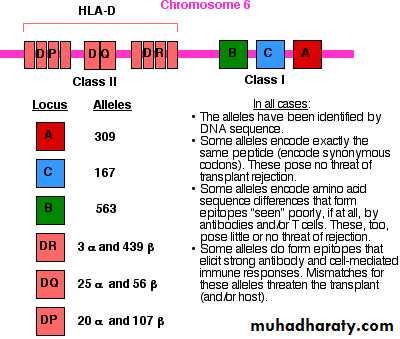Major Histocompatibility System
Major Histocompatibility System
A large highly polymorphic genomic region that control the types of cell antigens called MHC or HLA antigens.MHC : genes that determine the tissue compatibility between individuals.
Not only control the graft rejection but also forms a fundamental part of the normal function of the immune response.
HLA antigens are the major determinants used by the body 's immune system for recognition of self from non-self antigens.
Its importance was recognized from studies of the rejection of tissues between different members of the same species.
Every vertebrate species has MHC genes & products.
MHC genes
In humans, the MHC genes are located on chr. 6. They are found in regions A, B, C & D. The MHC complex is divided into three groupsGenes of class I MHC
There are 20 class I genes, the most important are A, B & C.
Genes of class II MHC
DP, DQ & DR. the 1st D indicates the class & the 2nd letter (P, Q & R) is the name of a specific locus.
Genes of class III MHC
C2 ,C4, BF, tumor necrosis factor
These genes are not related to class I or class II structurally & functionally.
It encodes molecules that are related to complement components and certain cytokines.
MHC genes
Pattern of expression
MHC class I molecules are expressed on almost every nucleated cell in the body and are adsorbed onto platelets.MHC class II molecules are confined to" immunocompetent cell " including B cells, dendritic cells, macrophages, thymic epithelial cells & activated T cells.
Expression of MHC molecules is increased by cytokines produced during the immune response.
Structure of MHC class I
MHC class I molecules are heterodimers consisting of a single transmembrane glycopeptide heavy chain (mol. wt. 43kDa), it comprises three extracellular domains α1,α2 & α3.It is associated non covalently with a light non- MHC- encoded polypeptide chain called β2- microglobulin ( mol. wt. 12 kDa).
It is structurally similar to Ig domain & is invariant among all class I molecules ( encoded by a gene on chromosome 15).
The part of molecule furthest from the membrane contains a deep groove which is made up of parts of α 1 & α 2 domains.
This groove is the binding site of peptides , it can bind 8-11 a.a. which has been derived from endogenous pathogens҆ antigens such as viral infection.
CD 8 T cells bind selectively to class I molecules,
CD 8 co receptor interacts with α3 domain of the heavy chain.
Structure of MHC class II
MHC class II molecules are heterodimers consisting of two homologous glycopeptides, α and β chain of mol. wt. 35 kDa & 28 kDa respectively.They are transmembrane peptide molecules with cytoplasmic tail & extracellular Ig-like domains, the domains are α1 & α2 and β1 & β2.
They consist of variable region & constant region.
The CD4 molecule binds the constant region of β2 chain.
MHC class II binds exclusively to CD4 T- helper cells.
The groove of MHC class II is formed by interaction between domains of α1 & β1 chains. It binds 10-30 a.a. derived from exogenous pathogens.
MHC class I & II
MHC alleles diversity
Each set of alleles is referred to as a haplotype. An individual inherits one haplotype from the mother & one from the father.The genes of both haplotypes are codominantly expressed. There are many alternative forms of genes or alleles at each locus. There are about 300 alleles for A, 500 for B, 150 for C & 500 for (DP, DQ &DR).
Therefore, the MHC loci has the greatest degree of polymorphism in the human genome.
In human, each HLA allele is given a numerical designation, e.g: an HLA haplotype of an individual could be HLA- A2, HLA-B5, HLA- DR3, and so on.
All heterozygous individuals have two HLA haplotypes.
The genes of haplotypes are inherited according to Mandelian Law of heredity; 25% of siblings are identical, 50% are partially identical and 25% are non-identical
MHC inheritance
Indications of HLA typing
Identification of good matches for tissue graft and organ transplantation.Determine the paternity of a child when in doubt.
Association with certain diseases. Individuals with certain HL A alleles have a greater risk of developing certain diseases such as ankylosing spondylitis with HLA-B27,
rheumatoid arthritis with HLA-DR4,
multiple sclerosis with DR2,
IDDM with DR3 & DR4
mysthenia gravis with DR3.
This association may be due molecular mimicry between the HLA Ag & the Ags of the causative agent or the HLA may act as a receptor for entry of pathogen into the cell.
HLA typing methods
• Serological techniqueA. Microlymphocytoxicity test
Principle: HLA antibodies with known specificity must be incubated with lymphocytes in the presence of complement .
Lymphocytes are lysed.
This is made visible using a stain and fluorescent microscope.
Used for typing HLA class I.
Microlymphocytotoxicity test
B. Mixed leukocyte reaction (MLR)
Principle: T lymphocyte from one individual proliferates in the response to leukocyte of another individual if they have differences in the alleles of the MHC genes. Used mainly for HLA class II.HLA typing methods
DNA-based typing techniqueSeveral DNA methods such as PCR replace serological test for the detection of HLA alleles of both class I & class II.
MHC genes can be amplified by PCR methods and the actual nucleotide sequence can be directly determined for the alleles of any cell.








